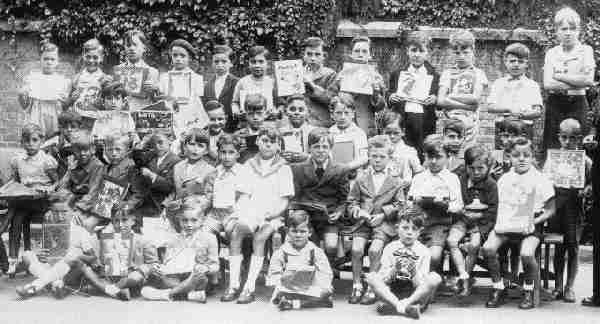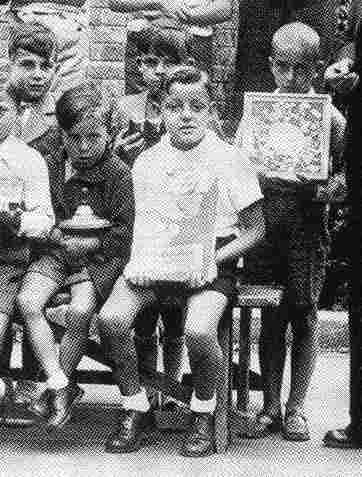
Figure 1.--Boys at this French primary school wore a wide range of clothes, including smocks, sailor suits, and suits. One boy wore a beret. They were common before World War II, but rapidly declined in popularity after the War.

A photograph of the boys at a primary school in 1947 show them receiving their prizes for superior work. The boys wear a wide variety of clothes, including smocks, sailor suits, and suits. Boys wear both shoes and sandals. Most boys wear ankle socks, but a few boys wear white kneesocks. The boys appear to be from different classes who were photographed together with their academic prizes. It is likely that during a normal school day that more of the boys would have come to school in smocks.
This photograph was taken in 1947, only a couple years after World War II. Economic conditions were still poor in France, but the children in this photographed are all smartly dressed.
The boys appear to jave been photographed at the end of the school year. The weather must have been warm, suggesting June or July.
A photograph of the boys at a primary school in 1947 show them receiving their prizes for superior work. HBC believes rthat the children dressed up for the occasion. Many probably did not wear their suits to school every day. It is likely that on a normal daty many more boys would have work smocks. They have received games and toys for their hard work.
The boys appear to be from different classes who were photographed together with their academic prizes. The children look to range from about 6-10 or 11 years of age.
French schools did not generally wear school uniforms. Many French boys wore smocks--a kind of uniform. Smocks were still common in the 1940s, but were no longer required at most schools and were beginning to decline in popularity. The boys at this ceremony wear a wide variety of clothes, including smocks, sailor suits, and suits--nearly all short opants suits. Boys wear both shoes and sandals. Most boys wear ankle socks, but a few boys wear white kneesocks. Many boys wear sandals. Virtually all the boys wear short pants, but a few boys in the back row do seem to be wearing games.
The children at this school ceremony wear quite a wide range of different garments. Some boys wear their school smocks, but only a few. This is perhaps because it was a special occasion. Other boys wear their best suits for the occasion. Many other styles are worn, including a white sailor suit.
Berets were once commonly worn by French school boys. In this photograph, only one boy wears a beret. The popularity of the beret declined sharply in the post war period. Many boys for some reason saw it as old fashioned. Actually it os a little surprising the one boy is wearing hos beret. You would have thought that he should have taken it off for the photograph. More boys may have worn berets to school, but not for the photogaph.
Quite a few of the boys wear suits. Nearly half of the boys have come to school in their suits, suggesting that this was a very special occasion. This may have been roughly the prportion of boys who had such suits because you would think the boys would have worn their suits if they had one. They are both light and dark colored suits worn with ties. They appear to be mostly standard boys' single breasted suits. One younger boy, however, wears a black suit with a small Eton collar. This style does not appear to have been very popular in France, but clearly was worn.
The sailor suit was once one of the most popular garments for French boys and was widely worn to school. On this occasion only one boy wears a sailor suit. The boy in the center of the group wears an imaculate white short pants sailor suit with classic styling. He wears white kneesocks and English-style school sandals with his sailor suit. He seems to be prominently placed in the middle of the group. He looks to be one of the older boys. Perhaps he won the top prize or perhaps he was placed there because he was so smartly dressed.
Some boys wear their school smocks, but only a few. This is perhaps because it was a special occasion. Smocks were once required at French schools, but by the 1940s this was mostly left up to the parents. Mothers had once insisted on smocks, but were lest adament after World War II, especuially as washing machines became more common. They were still very common in 1947. The boys that do wear smocks, wear many different styles. There are different colors, back and front buttoning smocks, and even what looks to be a short sleeved smock. Clearly the school did not have any guidelines on the type or color of smock. Details are difficult to concern, but one boy here wears a light colored back buttoning smock. A younger boy wears a light front buttoning smock.
Only a few boys wear sweaters. This is probably because it was such a nice day. On cooler days, many boys woukd have worn sweaters under their smocks.
One boy wears a rarther fancy puff sleeve. This was not a common style for a boy of school age, but clearly his mother wanted him looking his best for the occassioin. One boy wears a Peter Pan blouse. Other boys nmay wear blouses, but collar details are difficult to make out.
Most boys appear to be wearing white shirts. Short sleeved white shorts appear popular, although it is unclear what kind of shirts the boys in suits wear.
Although several boys wear suits, only a few boys wear ties with their suits.
Most of the boys wear short pants, although it is not possible to determine what all of the boys were wearing, especially the boys in the back row. All of the boys wearing suits where it is possible to dertermine wear shorts. One boy in the back row, the far right wears long pants. He is the only boy that we can determine to be wearing long pants.
Not all of the boys wear socks. Some boys wear sandals without any socks. White socks appear to have been very popular. The boys that do wear socks, at least the boys we can make out, all wear white socks. They wear both ankle and kneesocks, burt ankle socks are most common. Only two boys wear white kneesocks.
The boys wear a variety of footwear. Many boys wear what look to be brown lace-up leather shoes. One boy wears white shoes, but it is hard to make out the details. Quite a number of boys wear English-style school sandals. I'm not sure what color, They do not appear tohave been a casual style as some of the boys in suits wear the sandals.

Figure 5.--Many of the boys wear white shirts with a variety of short pants. The boy in the middle is another of the boys wearing his school smock. Notice the boy with the shave head. |
French boys are noted for the book satches they traditionally wore to school. One boy in the front row is earing his book satchel (gigure 1). Apparently he is anxious to go home after the cremony.
Thevboys wear short, but not close cropped hair. None of the boys have bangs. One boy has a shaved head.
A French reader tell us, "This page is very interesting. The class photo is a wondeful view of France in 1947. It is aperfect view of how boys dressed in the 1940s. The prize giving ceremony is always at the end of the school year, in middle June never in July. Holidays for children were July and August. The first and second prize are always a book; the following prizes can be a little book or a educational game ( such as Loto ). For this important ceremony, the children are dressed " en habit du dimanche " ( Sunday clothes ). Tthe rest of the
year many of the children probany wore smocks. Except the boys with the suit, which come probably of a ordinary family. It is impossible for the others boys to know their origin. All we were dressed alike in this style. Only it was possible to point out if the clothes were new or not. For this ceremony, it was current that the mayor and local
personalty came and give themself the first prizes. A little story:
"That happend in Nice and I recall well. I was invited on the podium
to help the Mayor for giving the prizes at the children. I was dressed
in a romper suit. I think it was one of last times I wore my romper suit. My hair was cut short. About the photo her, I think this ceremony probably happend not in Paris 1947; because in this case many more boys would have worn a more juvenile style. The puffed sleeves were very fashionable for boys up to 8 years at the time. I think it is more likely a country school with two or three classes .
If this photo was with boys less 6 years old, it surely would have had some bys wearing romper."
Related Chronolgy Pages in the Boys' Historical Web Site
[Main Chronology Page]
[The 1880s]
[The 1930s]
[The 1940s]
[The 1950s]
[The 1960s]
[The 1970s]
[The 1980s]
Related Style Pages in the Boys' Historical Web Site
[Main country page]
[Long pants suits]
[Short pants suits]
[Socks]
[Eton suits]
[Jacket and trousers]
[Blazer
[School sandals]
